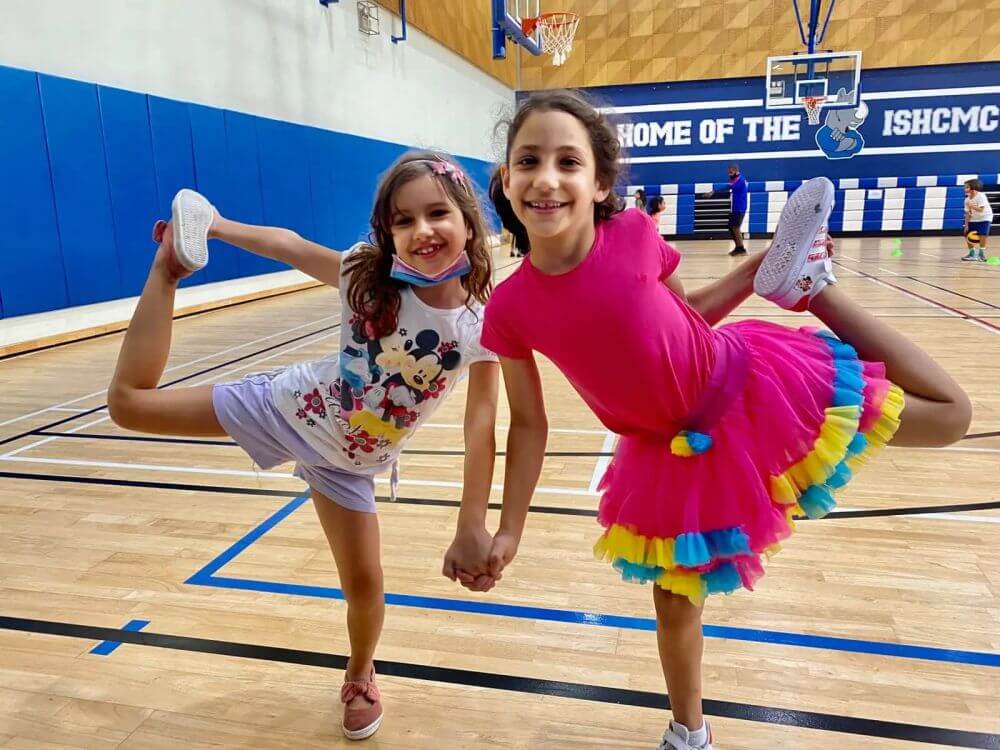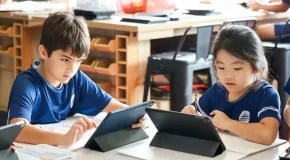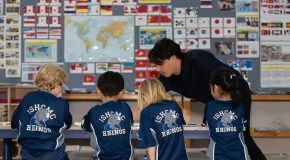30 Fun Back-to-School Activities for Preschoolers
Back-to-school activities for preschoolers are designed to nurture a wide array of skills, balancing logical reasoning, artistic creativity, and social communication. For parents looking to harness and expand their children’s creative talents, introducing a variety of activities can make learning enjoyable and holistic. Here are examples of engaging activities that promote comprehensive development in preschoolers, ensuring they get the most out of their early educational experiences:
Preschool Outdoor Activities
Outdoor activities offer a beneficial retreat from prolonged screen time, significantly enhancing children’s physical, intellectual, and mental well-being. A survey conducted for Outdoor Classroom Day reveals a compelling insight: 88% of teachers observed that children show improved learning abilities after engaging in outdoor activities. This statistic underscores the vital role that outdoor play and learning have in a child’s development.
1. Obstacle Course
Back-to-school preschool activities that involve high-intensity physical actions, such as obstacle courses, are excellent for stimulating children’s muscular development. These activities challenge children to navigate routes that require jumping, climbing, crawling, or balancing, promoting their physical strength, coordination, and motor skills for kindergarten.
- Tire runs: improving children’s spatial awareness by requiring them to hop from one tire to another.
- Crawling tunnels: developing gross motor skills and muscles by requiring children to crawl through obstacles.
- Rope swing: developing children’s grip strength, coordination, and judgment skills when swinging on a rope.
2. Bug Hunt
Engaging in a captivating bug-hunting adventure stimulates children’s imagination and hones their observational skills. As they discover the variety of insects in their natural habitats, they learn to appreciate and value biodiversity, fostering a sense of respect and care for the environment.
3. Make Mud Pies
Making a mud pie is a classic children’s activity that involves mixing water and soil to create a malleable mud mixture, which is then shaped and played with as if preparing real food or pies. This simple yet engaging activity is not just about getting messy; it’s a valuable sensory play that encourages creativity, imagination, and fine motor skill development.
Preschool Creative Arts and Crafts Activities
Creative arts and crafts activities are excellent for nurturing children’s artistic talents alongside their problem-solving abilities. These activities encourage children to think creatively, make decisions, and develop fine motor skills. Here are some recommended arts and crafts ideas to foster creativity and problem-solving in your children:
4. Rain Splatter Painting
This art activity provides a unique experience that combines nature and creativity.
- Material: Require simple painting tools like drawing or construction paper, tempera paint, and paintbrushes. Specifically, choose a rainy day to enjoy the activity.
- Instruction: Give your child the freedom to paint with random drops and lines on the paper. Afterward, place the picture outdoors and enjoy the unpredictable experience of letting the raindrop finish the masterpiece with unique splashing patterns.
- Benefits: It entertains children’s minds with affection for the beauty of nature. Moreover, their curiosity to experiment with different combinations of colors properly enhances their unlimited creativity.
5. Finger Painting
Finger painting is a fantastic sensory activity that allows children to explore their creativity while developing motor skills and hand-eye coordination. It’s not just about making art; it’s about the process of experimenting with colors, textures, and patterns. Here’s how you can introduce finger painting to your child:
- Material: include homemade/shop-bought finger paint, old clothes or waterproof smock, and cleaning materials.
- Instruction: tell preschoolers to create shapes, images, and unique patterns on the paper with their fingers and hands.
- Benefits: encourage children to develop their imagination and creative sense through random selections of colors.
6. Puzzle
Arranging puzzle pieces is an activity that promotes logical thinking and problem-solving skills, offering a captivating challenge that appeals to children of various ages. Puzzles come in a wide array of themes, sizes, and levels of complexity, making it easy to find options that are both age-appropriate and engaging for your child.
- Material: use wood, foam, and cardboard to create puzzle pieces.
- Process: solve the puzzle by combining pieces individually or collaboratively.
- Benefits: Enhance children’s problem-solving skills and hand-eye coordination. Besides, it nurtures their patience and confidence with meaningful achievements.
Preschool Mathematical Activities
Math activities for preschoolers are designed to be interactive and hands-on, offering young learners an engaging way to develop their problem-solving skills and grasp basic mathematical concepts. These activities move away from traditional worksheets or digital screens, instead providing a tangible and playful approach to learning.
7. Sorting Buttons
Sorting buttons is a simple yet effective math activity for preschoolers that combines learning with tactile fun. It helps children understand concepts like sorting, counting, and categorizing while also enhancing their fine motor skills.
- Material: Buttons with different shapes, sizes, and colors. Containers or sections for sorting.
- Instruction: Challenge preschoolers to categorize buttons based on specific attributes from the original complicated mixed collection.
- Benefits: Introduce children to the basic mathematical concepts of sequence and categorization. Children can improve their critical thinking and decision-making skills by practicing pattern recognition and observation ability.
8. Cup Stacking
Cup stacking, also known as speed stacking, is an engaging and energetic activity that helps develop fine motor skills, hand-eye coordination, and quick thinking in preschoolers. It involves stacking plastic cups in specific configurations in as little time as possible. Here’s how to introduce cup stacking to preschoolers:
- Introduce the Cups: Begin by letting the children explore the cups, understanding how they fit into each other and can be stacked and unstacked.
- Basic Stacks: Teach them simple stacking formations, like a 3-2-1 pyramid (three cups at the base, then two, then one on top). Let them practice stacking up and breaking down the pyramid.
- Sequenced Stacking: Once they’re comfortable, introduce a sequence of actions, like creating a pyramid, then unstacking it to form a single column.
9. Graphing
Graphing is a fantastic way to introduce preschoolers to basic math and data analysis concepts in a visual and interactive way. Even at a young age, children can learn to compare, sort, and categorize items, and graphing helps translate these skills into visual information.
- Material: Require large paper or board. Use stickers or cut-out shapes to create the graph based on specific themes such as pets, colors, or favorite fruits.
- Instruction: Choose a topic and ask preschoolers to graph that information with appropriate elements. Review the results with friends and discuss the adjustment for the graph.
- Benefits: Graphing activities help preschoolers understand the relationship between patterns and data. They also introduce them to math’s comparative concepts like more than, less than, and equal to. Spending more time on graphing activities helps children learn approaches to interpreting complicated statistics into understandable information.
Preschool STEM Activities
STEM activities for preschoolers blend concepts from science, technology, engineering, and mathematics into engaging, hands-on learning experiences. These activities are designed to foster curiosity, enhance problem-solving abilities, and develop critical thinking skills in young learners. Here are some STEM activities tailored for preschoolers:
10. Sink or Float
This activity serves as an experiment to educate children about density and buoyancy.
- Material: Use a large bowl or tub to contain water. Prepare a range of objects of different sizes and shapes to experiment with.
- Instruction: Ask preschoolers to predict whether the object can sink or float. Gather them to discuss the observation, explain the reasons behind the results, and educate them about the density concept.
- Benefits: Sink or Float activity helps understand an observation’s outcome based on physical science concepts. Besides, the nurture of hypothesis testing skills fosters the child’s curiosity to experiment with things in life.
11. Lava Lamp
DIY lava lamp experiment supports children to explore the concept of chemical reactions and density.
- Material: a clear plastic bottle, food coloring, vegetable oil, and Alka-Seltzer tablets.
- Instruction: Fill one-third of the bottle with water and a few drops of food coloring, then fill the rest with oil, leaving a little space at the top. Break the Alka-Seltzer tablet into small pieces and drop a piece into the bottle to create the lava lamp effect.
- Benefits: The lava lamp activity nurtures children’s interest in physical and chemical sciences. Specifically, preschoolers can learn the immiscibility of oil and water and the chemical reaction that creates a bubbling lava effect.
12. Color Changing Flowers
Observing the change in flowers’ color assists children in understanding the capillary actions in plants.
- Material: require food coloring, carnations, daisies, or other white flowers, water, and clear glasses.
- Instruction: pour water into each glass and colorize it with different food coloring. Place flowers’ stems after being cut on each glass. Afterward, wait for the fascinating results of color changes over the next 24 or 48 hours.
- Benefits: This practical activity encourages children’s patience when waiting and observing the color changes of flowers. Preparing and enjoying the results will educate them about how flower stems absorb the water and capillary actions.
Preschool Music and Movement Activities
Integrating music and rhythm into learning activities offers preschoolers a dynamic way to explore their emotions and enhance their motor skills through body movement. These activities are not only enjoyable but also crucial for their developmental growth, allowing children to express themselves creatively and connect with music in a meaningful way. Here’s how such activities can be structured:
13. Free Dance
Free dance activity allows children the freedom of movement to visualize the rhythm of the prepared music.
- Material: Prepare a diverse music list with different genres and tempos.
- Instruction: Play the music and let the children perform unique dances with random movements.
- Benefits: Free dance activity nurtures the preschoolers’ artistic talents when exploring their musicality sense. Besides, it enhances children’s confidence in expressing themselves through movements to be free of emotions.
14. Scarf Dancing
This activity provides colorful scarves as visual elements to support the dancing’s movement.
- Material: lightweight and colorful scarves, music.
- Instruction: Give each preschooler a scarf. Ask children to wave their scarves and move their bodies when the music plays to create unique choreography.
- Benefits: Scarf dancing enhances children’s creativity while granting freedom with the scarf movement’s visual effect. Besides, it helps them overcome their fear of stage performance with more self-confidence.
15. Balloon Dancing
This dancing activity offers a more fun and challenging playstyle with support from colorful balloons.
- Material: One balloon per child, music
- Instruction: Distribute inflated balloons to each child. Play the music and challenge them to move their body without letting the balloon fall. The gameplay can allow for teamwork mode when requiring them to pass the balloons back and forth.
- Benefits: Balloon dancing develops children’s versatility and spatial awareness. Moreover, this activity improves their cooperation and communication skills with their friends.
Preschool Literacy and Language Development Activities
Literacy and language development activities are essential for preschoolers, as they lay the groundwork for future academic success by enhancing reading, writing, and communication skills. These activities are designed to be engaging and interactive, fostering a love for language and communication from an early age. Here’s how these activities can support young learners:
16. Alphabet Knock Down
The “Alphabet Knock Down” game is a fun and educational activity that combines physical movement with literacy learning, ideal for preschoolers to reinforce their knowledge of the alphabet. Here’s how to set it up and play:
- Material: Empty cans or plastic cups, a marker, and a soft ball or bean bag
- Instruction: Write a different alphabet letter on each can or cup. Arrange letters in a pyramid or another stable structure. Children throw the ball or bean bag to knock down the cans or cups. When knocking down a can or cup, the child identifies the letter and makes the corresponding sound.
- Benefits: Integrating physical aspects into the activity provides an engaging way to improve children’s literacy skills. Specifically, it helps children associate letters with sounds, an essential skill for reading.
17. Magic Letter Painting
Magic Letter Painting stimulates children’s artistic senses to improve letter recognition.
- Material: White crayon or candle, white paper, watercolor paints, and a paintbrush
- Instruction: Use the white crayon or candle to create the invisible letters on paper. Children will paint over the paper with watercolors to gradually explore the hidden letters.
- Benefits: This activity stimulates visual and tactile learning, making it particularly effective for children who are visual learners or enjoy hands-on activities. It encourages letter recognition and can be adapted to focus on individual letters, a child’s name, or simple words.
18. Fingerprint Letters
Fingerprint Letters activity offers an effective sensory and entertaining way for children to practice writing letters.
- Material: Ink pads or paint, paper, and markers
- Instruction: Children press their fingers onto the ink pad or into paint and then onto paper to create dots. They connect these dots with a marker or use more fingerprints to form letters and words. You can expand the challenge’s scope when requiring children to create illustrated stories or messages with fingerprints.
- Benefits: Creating letters and words with fingerprints can help children remember letter shapes and the sequence of letters in words, reinforcing spelling and reading skills.
Preschool Social Skills Building Activities
Social skills-building activities are crucial for preschoolers, helping them develop key competencies in communication, emotional regulation, and cooperation. These skills are foundational for successful interactions both in school and in daily life. Here are some activities designed to enhance social skills in young children:
19. Simon Says
This classic game educates children on listening and following instructions and nurtures the first seed of leadership.
- Instruction: Assign one person as a leader named Simon. Simon commands the others, such as, “Simon says touch your toes.” Participants should only follow the command if it starts with “Simon says.” If Simon gives a command without saying “Simon says” first, and someone follows it, they’re out for that round. The game emphasizes careful listening and quick response to instructions.
- Benefits: This game enhances listening skills, attention to detail, and self-control. When children take turns being Simon, they learn leadership skills and how to communicate clearly and effectively.
20. Pretend Play
Imaginative play allows children to participate in various scenarios based on their active roles.
- Material: Items like toy phones, cooking sets, costumes, or props that spur imagination can enhance the experience.
- Instruction: children assume roles and engage in a storyline, whether playing house, pretending to be superheroes, or running a kitchen. This type of play is often spontaneous and unpredictable based on the children’s ideas and interactions.
- Benefits: The pretend play develops language and communication skills by narrating their roles and actions.
21. Emotional Charades
Emotional Charades provides a fun and engaging way for preschoolers to express their emotions.
- Material: Cards with different emotions (happy, sad, angry) written on them.
- Instruction: Players take turns drawing a card and then acting out the emotion without using words while the others guess the portrayed emotion. The game can include scenarios to add more challenges in eliciting the emotion.
- Benefits: The Emotional Charades game educates children on understanding facial expressions and body language. Besides, it provides a safe space to explore and control feelings.
Preschool Health and Wellness Activities
Health and wellness activities are vital in teaching preschoolers about hygiene, self-care, and the importance of maintaining healthy habits throughout their lives. These activities can be fun and interactive, embedding essential health lessons into their daily routine. Here’s how you can incorporate health and wellness into engaging activities for children:
22. Sing Hand Washing Songs
Sing Hand Washing Songs activity supports children in nurturing healthy habits based on a foundational understanding of hygiene.
- Material: A handwashing station with soap and water and a device to play music.
- Instruction: Teach children handwashing songs that last at least 20 seconds (the recommended time for effective handwashing by health organizations). Popular tunes can include “Happy Birthday,” sung twice, or other catchy songs about handwashing. Encourage children to scrub all parts of their hands while singing the song before rinsing.
- Benefits: This interactive activity turns handwashing into a memorable and enjoyable practice, ensuring children engage in proper hygiene regularly.
23. Dentist Visit Game
The Dentist Visit Game helps preschoolers mitigate their fear and anxiety of dentists. It also educates them on dental hygiene and the importance of regular dentist check-ups.
- Material: A toy dentist kit, including a toothbrush, mirror, and pretend dental tools. Use any regular chair to simulate the dentist’s one.
- Instruction: Children take turns playing the role of the dentist and the patient. The “dentist” examines the “patient’s” teeth, checking for cavities pretendedly and demonstrating proper brushing techniques. Discussing what happens during a dental visit and why it’s essential can be part of the game.
- Benefits: This role-playing game familiarizes children with dental care routines, reducing fear and anxiety about visiting the dentist. It educates them about oral hygiene in an interactive manner, encouraging healthy dental habits from an early age.
24. Read Germ Books
This activity fosters healthy habit development by providing knowledge about germs and hygiene practices.
- Material: Picture books about germs and hygiene that are age-appropriate and engaging.
- Instruction: Read books to the children that explain the germs’ definition, effects, and why practices like handwashing, sneezing into an elbow, and not sharing personal items like utensils are essential for health.
- Benefits: This activity demystifies the concept of germs and disease transmission in an easy-to-approach way for children. Moreover, it develops their listening and comprehension skills to nurture a better understanding of personal health care.
Preschool Reading Activities
This activity provides valuable resources for children and parents with flexible and structured guidelines.
25. Explore Interest Based Booklets
These booklets provide tailored content to nurture children’s personal interests.
- Content: These booklets typically include activities, facts, and projects related to a specific topic of interest. They might contain coloring pages, simple experiments, crafts, and puzzles designed around the child’s interests.
- Benefits: Interest-based booklets engage children in learning by aligning with their natural curiosities and passions. This approach enhances motivation and retention of information, encourages self-directed learning, and can help develop a lifelong love for exploration and discovery.
26. Explore Back to School Books
Back-to-school books for preschoolers support mental preparation in anxiety, teachers, and friends before transitioning to school.
- Content: include stories about characters experiencing their first day back at school, tips for making new friends, and activities that simulate school scenarios. They may also allow children to express their feelings and thoughts about returning to school.
- Benefits: these booklets ease the transition into a new school year, helping children feel more prepared and less anxious about the changes.
27. Explore Problem-Solving Books
These booklets develop children’s critical thinking and problem-solving skills through engaging stories and activities.
- Content: include puzzles, stories with dilemmas, and guided activities that require the child to think critically to find solutions. They often feature relatable scenarios that children might encounter in their own lives, such as dealing with a mistake or resolving conflicts with friends.
- Benefits: Problem-solving books help children navigate challenges independently and confidently. Besides, they deliver valuable life skills such as resilience, decision-making, and creativity in finding solutions.
Preschool Group-based Activities
Interactive activities are fantastic for promoting physical activity, social interaction, and learning through engaging gameplay.
28. Balloon Battle
This easy-to-setup activity offers preschoolers the joyful feeling of teamwork and coordination when controlling the balloons.
- Material: One or several balloons, depending on the number of participants and the difficulty level desired.
- Instruction: Inflate a few balloons and divide the children into two teams. The objective is to keep the balloons from touching the ground using any part of the body except the hands. One team scores a point whenever the opposing team lets a balloon touch the ground.
- Benefits: This activity enhances hand-eye coordination, promotes physical activity, and encourages children’s teamwork and communication.
29. Duck Duck Goose
This activity is a challenging game that boosts the children’s speed, agility, and spatial awareness while chasing and running.
- Instruction: Children sit in a circle facing inward. One child, the “it,” walks around the outside of the circle, tapping each child on the head and saying “duck” until choosing someone to be the “goose.” The “goose” then rises, and both the “it” and the “goose” run around the circle in opposite directions, trying to return to the vacated spot first. The one left standing becomes the new “it.”
- Benefits: The activity brings a joyful experience for children when participating in teamwork, fostering better cardiovascular fitness, agility, and reaction time.
30. Animal Yoga
This activity introduces children to the excitement of yoga through the engaging lens of imitating animals, promoting physical flexibility, balance, and calmness.
- Material: A clear space large enough for children to move around safely.
- Instruction: Guide the children through a series of yoga poses that mimic animals, such as “cat-cow,” “downward-facing dog,” or “cobra.” Explain how each pose is related to the animal and its benefits. You can make the activity more engaging by telling a story that includes traveling through a jungle or forest and encountering different animals (poses) along the way.
- Benefits: Animal Yoga encourages children to explore movement and the capabilities of their bodies in a fun, imaginative way. Additionally, the mindful aspect of yoga helps children learn focus and relaxation techniques, contributing to emotional regulation and stress reduction.
FAQs
Setting your children up for back-to-school activities requires detailed mental preparation and safety procedures. Here are the answers to common questions parents ask when encountering this issue.
How do I know if my child is ready for preschool?
Your child may be ready for preschool if they show signs of independence, such as following simple instructions and building a simple habit. Besides, the eagerness to explore the world outside is a positive signal to bring your child to preschool activities.
How can I emotionally prepare my child for preschool?
You should talk with your children about preschool positively and excitingly, sharing details about expected things, such as making new friends and learning new things.
Are there specific safety measures I should consider for back to school activities for preschoolers?
For back to school activities for toddlers, ensure that the environment is safe with age-appropriate materials, and maintain a clean setting to minimize health risks. Additionally, it’s crucial to establish clear safety routines for your child, such as handwashing and staying with the group during outings.
Join Back-to-School Activities at ISHCMC
Back-to-school activities for preschoolers nurture their first impression of the outside world regarding academic knowledge and social relationships. Using simple ideas mentioned in the article, parents can establish and join activities to experience and explain the fun of life to their toddlers.
ISHCMC primary and secondary schools support improving students’ leadership, teamwork, critical thinking, and other foundational skills based on the IB programme’s curriculum and wide range of co-curricular activities.
With over 150+ activities across sports, social, cultural, and academics, students are able to develop leadership skills, build confidence, learn to work collaboratively with others while pursuing their individual interests, and socialize with their peers beyond the classroom.






